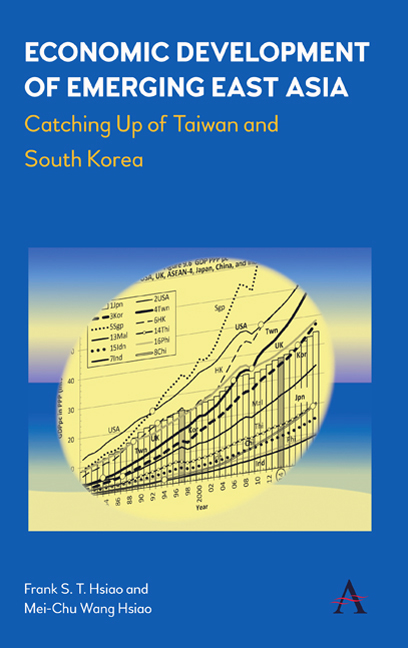Book contents
- Frontmatter
- Dedication
- Contents
- List of Figures
- List of Tables
- Sources of the Chapters
- Acknowledgments
- About the Authors
- Introduction
- Part I Studies of Emerging East Asian Economies: Taiwan and Korea
- Part II Catching Up and Convergence in East Asian Economic Growth
- 6 Miracle or Myth of Asian NICs’ Growth: The Irony of Numbers
- 7 “Miracle Growth” in the Twentieth Century: International Comparisons of East Asian Development
- 8 Catching Up and Convergence: On the Long-Run Growth in East Asia
- 9 Epilogue: From Emerging East Asia to an Asia-Centered World Economy
- Index
6 - Miracle or Myth of Asian NICs’ Growth: The Irony of Numbers
from Part II - Catching Up and Convergence in East Asian Economic Growth
Published online by Cambridge University Press: 10 January 2018
- Frontmatter
- Dedication
- Contents
- List of Figures
- List of Tables
- Sources of the Chapters
- Acknowledgments
- About the Authors
- Introduction
- Part I Studies of Emerging East Asian Economies: Taiwan and Korea
- Part II Catching Up and Convergence in East Asian Economic Growth
- 6 Miracle or Myth of Asian NICs’ Growth: The Irony of Numbers
- 7 “Miracle Growth” in the Twentieth Century: International Comparisons of East Asian Development
- 8 Catching Up and Convergence: On the Long-Run Growth in East Asia
- 9 Epilogue: From Emerging East Asia to an Asia-Centered World Economy
- Index
Summary
Abstract
Krugman (1994) has argued that the East Asian NICs’ economic growth has been input-driven, that is, not attributable to technical progress or “efficient growth”; therefore, their growth presents no economic miracle. His argument is based on total factor productivity (TFP) studies of other economists. This chapter carefully compares their results with other similar calculations of TFP growth rates. Section 6.2 recaptures the essence of the so-called Asian miracle in terms of real GDP growth rates. Section 6.3 explains TFP. We then compare TFP growth rates and TFP contributions of Asian NICs and some OECD countries in Section 6.4. Comparisons with similar estimates of other developing countries are given in Section 6.5. Section 6.6 presents some concluding remarks. We find that under the current state of the art, it is not convincing to make any prediction on the future of Asian NICs and Asian development based on a few statistical results.
Introduction
In 1979, an OECD report (1979) defined ten newly industrializing countries (NICs). In addition to the four “Asian NICs,” namely, South Korea, Taiwan, Hong Kong and Singapore, the group also included Mexico, Brazil, Greece, Portugal, Spain and the former Yugoslavia. The NICs “are characterized by a fast growth of the level and share of industrial employment, and enlargement of export market shares in manufactures.” In addition, a rapid growth of real per capita GDP since the 1960s has also been pointed out (6 and 19). By the end of the 1980s, it turns out that only the four Asian NICs remained as NICs. The rapid growth rates of other NICs were not sustained (WDR, 1989). Thus, economic growth of the Asian NICs has been regarded as an economic “miracle.” Furthermore, in the place of other non– East Asian newly industrializing countries, the four ASEAN countries (referred here as ASEAN-4), Malaysia, Thailand, Indonesia and the Philippines, started growing so rapidly after the 1970s that they are now considered as quasi-NICs. The performance of China after the 1978 reform, especially since the mid-1980s, along with Vietnam and India in recent years, has also been very respectable. Thus, it is said that the Pacific Century has already begun, led by Japan and the United States in the region (Kim and Young, 1987; Park and Park, 1989).
- Type
- Chapter
- Information
- Economic Development of Emerging East AsiaCatching Up of Taiwan and South Korea, pp. 157 - 176Publisher: Anthem PressPrint publication year: 2017



